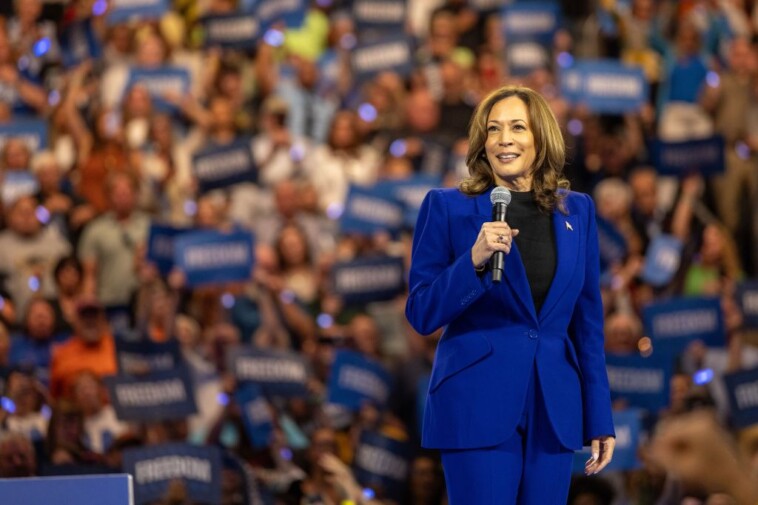Vice President Kamala Harris has announced a sweeping set of proposals on housing policy, giving voters their first look at what the housing market might look like under a Harris administration.
Harris unveiled the proposals as part of a populist economic plan that marked her first major policy announcement since replacing President Joe Biden at the top of the Democratic ticket in the 2024 presidential race against Republican Donald Trump.
Her signature housing policy calls for up to $25,000 in federal down payment assistance for first-time homebuyers who have paid their rent on time for at least two years. That dramatically expands on Biden’s prior proposal for a $10,000 tax credit for first-time buyers, which had limited additional down-payment assistance to first-generation homebuyers.
The Harris campaign says in a statement that the program would provide down payment assistance to up to 4 million first-time buyers over four years.
Other elements of the plan called for a new tax credit for builders incentivizing the construction of starter homes, curbs on investor purchases of single-family homes, and a ban on shared software platforms used by landlords to set rent, which critics say is a form of price fixing.
Altogether, Harris says she would push for construction of 3 million new housing units over a four-year term. It’s an attainable goal, with U.S. Census Bureau data showing that 1.5 million new privately constructed housing units were completed in 2023 alone.
Her key proposals, including down payment assistance, would require congressional approval. The nonprofit policy group Committee for a Responsible Federal Budget estimates that the new housing policies Harris proposes would cost $200 billion over four years, and more if they were made permanent.
Harris’ campaign vows follow a massive surge in home values that has left existing homeowners sitting on a mountain of equity, while freezing many prospective first-time buyers out of the market. In May, national home prices were up 48% from four years earlier, according to Case-Schiller.
“As the price of housing has gone up, the size of down payments have gone up as well. Even if aspiring homeowners save for years, it often still is not enough,” Harris said in a speech on Friday in the swing state of North Carolina.
Harris’ down payment proposal was light on specific details—who exactly would qualify for down payment assistance, and how would the funds be distributed? But the plan quickly sparked heated debate, with some housing policy experts praising the proposal and others warning it could fuel runaway increases in home prices.
The Trump campaign also quickly slammed the proposal, with Republican vice presidential candidate J.D. Vance claiming “Kamala Harris wants to give $25,000 to illegal aliens to buy American homes.”
It is unclear whether the Harris plan would have a citizenship requirement, but immigrants present in the country unlawfully are not eligible to apply for traditional, or “conforming,” mortgages. Depending on how the program was administered, that could also make them ineligible for federal assistance with a down payment.
Experts react to Harris’ down payment assistance plan
Several economists who spoke to Realtor.com cautioned that Harris’ plan could backfire by stoking demand in an already hot housing market, driving home prices even higher.
Ken Johnson, a professor of finance and the Walker Chair of Real Estate at the University of Mississippi, warns that offering widespread down payment assistance would be like “throwing gasoline on an already on-fire housing market.”
“The real symptom of what’s going on is that we’re short in supply. We’re dangerously short in supply. We just cannot build homes fast enough,” says Johnson. “You can’t make it easier for people to buy homes, and offer easier credit to buy homes, when you have the housing market so overpriced.”
Johnson argues that to bring home prices back into reach, the government should do more to help small and independent homebuilders secure financing.
One way, he explains, would be to launch a government-sponsored enterprise dedicated to purchasing construction loans, the way Fannie Mae and Freddie Mac purchase mortgages.
Tai Christensen, president of private-sector down payment assistance provider Arrive Home, acknowledges that a federal subsidy for first-time buyers might stoke housing inflation if it were not balanced with an increase in supply.
However, she argues that Harris’ proposed tax credits for homebuilders could offset the inflation risk by stimulating new construction, and that down payment assistance would be an important step to level the playing field and boost opportunities for homeownership.
“Anything that increases homeownership, specifically in marginalized, low- to moderate-income communities, we are in complete support of,” says Christensen. “Homeownership is the No. 1 vehicle for wealth creation for the majority of Americans, and to have opportunities to expand that benefit to more Americans, we’re completely in support of whatever that looks like.”
The National Association of Home Builders praised Harris for making housing and homeownership a centerpiece of her economic agenda.
“We are pleased that the foundation of her plan calls for the construction of 3 million new housing units because the primary way to tackle the nation’s housing affordability crisis is to increase the nation’s housing supply,” said NAHB Chair Carl Harris in a statement.
He said that new tax credits for builders would help boost construction, but warned that “any tax incentive to support the production of starter homes must be targeted to local market conditions and be widely available.”
Carl Harris, no relation to the vice president, also reiterated his group’s longstanding call to cut federal regulations and codes that he says are burdensome and costly to homebuilders.
‘The devil is in the details’
If Kamala Harris does receive congressional approval for a down payment assistance program, it wouldn’t be the first time the federal government has subsidized homebuyers.
In 2009, during the depths of the global financial crisis, Congress passed a similar $8,000 credit for first-time homebuyers. But 2009 was a very different situation, when home prices were plunging due to a huge pullback in demand and an influx of buyers was needed to stabilize the market.
Now, many economists believe we are in the opposite sort of crisis: The supply of homes is inadequate to meet demand, pushing home prices out of reach for many families.
“The housing market is still way out of whack compared to where it should be,” says professor Johnson. Following the Great Recession, “We in the U.S. and around the world did not build housing product for a decade, virtually none. So we fell way behind.”
From 1996 to 2006, the U.S. completed an average of 1.6 million new housing units every year. Construction plunged over the following five years, bottoming out at just over a half-million units in 2011. Since then, construction has slowly climbed each year, but it has yet to return to the levels seen prior to the 2007 housing market crash.
As builders constructed fewer homes after the crash, they also began focusing on larger, more expensive homes, which have higher profit margins. In 2015, the median square footage of new single-family homes peaked at 2,473, up from the 2,088 average in the decade through 2006.
New home sizes have slowly tapered since then, but remained well above the pre-financial crisis average last year, at 2,238 square feet.
Harris may hope that, by providing builder tax credits and buyer subsidies specifically in the first-time buyer category, it will stimulate the market for starter homes and encourage more builders to pivot toward more affordable homes suited for first-time homebuyers.
Arrive Home’s Christensen notes that today, the starter home category may often include units in multifamily properties such as duplexes and quads, which are cheaper to build than free-standing homes, but still allow lower-income buyers to start building equity.
“When people think of starter homes, sometimes they have this kind of vision in their head of a white picket fence and a three-bedroom, two-bath rambler with a yard,” she says. “But planned urban developments are typically cheaper than your average suburban neighborhood, and specifically for first-time homebuyers, that’s critical, because they just need to get their foot on the property ladder.”
Matthew S. Roland, assistant dean for the Real Estate Development program and clinical assistant professor at the University at Buffalo School of Architecture and Planning, notes that for an FHA mortgage with 3.5% down, a $25,000 down payment credit could cover the down payment for a home of up to $715,000.
However, at 20% down, the credit would cover the down payment for a home only up to $125,000, a price range that is virtually nonexistent aside from some condo units.
Roland says key questions about the program remained to be answered, including how homebuyers would qualify, whether they’d have to put some of their own money down as well, and whether the funds would be distributed as a tax credit or direct payment to the lender.
“Overall, I think it’s a program that has the potential to help,” says Roland. “That said, the devil is in the details.”






